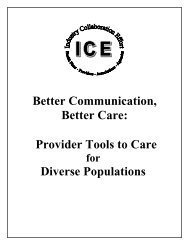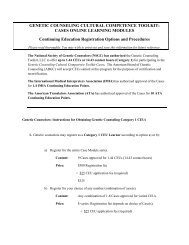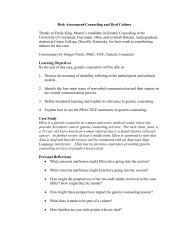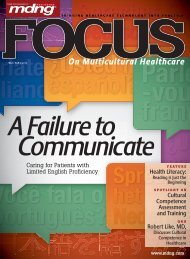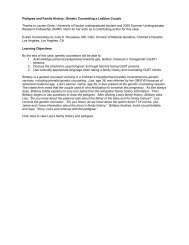Advanced Effective Communication, Cultural Competence, and ...
Advanced Effective Communication, Cultural Competence, and ...
Advanced Effective Communication, Cultural Competence, and ...
You also want an ePaper? Increase the reach of your titles
YUMPU automatically turns print PDFs into web optimized ePapers that Google loves.
A Roadmap for Hospitals<br />
Appendix E: Resource Guide<br />
• Professional Chaplaincy: Its Role <strong>and</strong> Importance in<br />
Healthcare, which describes the role <strong>and</strong> significance of<br />
spiritual care. This publication is the first joint<br />
statement on the subject prepared by the five largest<br />
chaplaincy organizations in North America. Available at<br />
http://professionalchaplains.org/index.aspx?id=229.<br />
• We Speak the Language: Chaplains Offer Vital Role in<br />
Patient Centered <strong>Communication</strong> describes, with case<br />
illustrations, how professional chaplains help identify<br />
cultural <strong>and</strong> religious beliefs <strong>and</strong> values that are important<br />
elements of patient <strong>and</strong> family underst<strong>and</strong>ing <strong>and</strong><br />
communication with the health care team. Available at<br />
http://professionalchaplains.org/uploadedFiles/pdf/<br />
We%20Speak%20the%20Language%20H<strong>and</strong>zo%20<br />
Wintz%20Oct06%20Healing%20Spirit.pdf.<br />
2. HealthCare Chaplaincy’s A National Survey of Health Care<br />
Administrators’ Views on the Importance of Various Chaplain<br />
Roles addresses eleven chaplain roles <strong>and</strong> functions as<br />
viewed by hospital administrators to support the<br />
emotional <strong>and</strong> religious needs of patients. Available at<br />
http://www.healthcarechaplaincy.org/userimages/<br />
a-national-survey-of-health-care-admin-views-onchapl-roles.pdf.<br />
3. The Southern Medical Journal details the doctor’s <strong>and</strong><br />
chaplain’s roles in caring for the patient’s spirituality in<br />
Hanzo <strong>and</strong> Koenig’s 2004 article “Spiritual care: Whose<br />
job is it anyway?” It recommends spiritual assessment as<br />
part of the patient’s overall assessment. Available by<br />
request from HealthCare Chaplaincy at http://www.<br />
healthcarechaplaincy.org/chaplaincy-researchresources/articles-by-request.html.<br />
4. LaRocca-Pitts, in the September 2006 article “A new<br />
hospitalist in the house: The in-house chaplain’s role on<br />
the hospital medical team” published in The Hospitalist,<br />
draws a comparison between chaplains <strong>and</strong> hospitalists.<br />
Available at http://www.the-hospitalist.org/details/<br />
article/239573/A_New_Hospitalist_in_the_House.html.<br />
5. American Geriatrics Society’s Doorway Thoughts: Cross-<br />
<strong>Cultural</strong> Health Care for Older Adults, Volume III is<br />
designed to help physicians <strong>and</strong> other health providers<br />
develop a better underst<strong>and</strong>ing of the role that religion<br />
plays in the health care decision making of patients <strong>and</strong><br />
their families. This volume contains chapters about<br />
Buddhism, Confucianism, Hinduism, Islam, Judaism,<br />
Shamanism practiced by Hmong, <strong>and</strong> Sikhism. Each<br />
chapter concludes with a case study that illustrates the<br />
application of concepts presented in the chapters. Book<br />
description <strong>and</strong> purchase information available at<br />
http://www.americangeriatrics.org/publications/shop_<br />
publications/education__clinical_tools_for_health_care_<br />
providers/.<br />
6. The Tanenbaum Center for Interreligious Underst<strong>and</strong>ing<br />
(http://www.tanenbaum.org) published The Medical<br />
Manual for Religio-<strong>Cultural</strong> <strong>Competence</strong>: Caring for<br />
Religiously Diverse Populations that includes<br />
communication tips <strong>and</strong> guides, information on ten of the<br />
world’s largest religions <strong>and</strong> how they intersect with health<br />
care <strong>and</strong> real tools to help providers manage their patients’<br />
religious needs. Available for purchase at<br />
http://www.amazon.com/Medical-Manual-Religio-<br />
<strong>Cultural</strong>-<strong>Competence</strong>-Religiously/dp/B0033T7O8Q.<br />
7. Healthy House’s program Shaman <strong>and</strong> Physicians Partner<br />
for Improving Health for Hmong Refugees offers an<br />
opportunity to the Hmong shaman <strong>and</strong> physicians from<br />
the local hospital to exchange health care experiences <strong>and</strong><br />
information. More information available at<br />
http://www.healthyhousemerced.org <strong>and</strong><br />
http://www11.georgetown.edu/research/gucchd/nccc/<br />
documents/Hmong%20Refugees.pdf.<br />
Addressing the Needs of Patients with<br />
Disabilities<br />
1. The Barrier Free Healthcare Initiative provides resources<br />
on its Web site specifically addressing health care access<br />
for people with disabilities, including listing some of the<br />
common barriers faced by people with disabilities.<br />
Available at http://thebarrierfreehealthcareinitiative.org.<br />
2. World Institute on Disability’s video Access to Medical<br />
Care: Adults with Physical Disabilities offers physicians,<br />
dentists, nurses, social services, <strong>and</strong> support staff an<br />
introduction to crucial issues that affect the quality of care<br />
for patients with disabilities in outpatient clinical settings.<br />
A training curriculum is also available. A free preview <strong>and</strong><br />
purchase information are available at http://www.wid.org/<br />
programs/health-access-<strong>and</strong>-long-term-services/access-tomedical-care-adults-with-physical-disabilities.<br />
3. The Center for Universal Design <strong>and</strong> The North Carolina<br />
Office on Disability & Health’s Removing Barriers to Health<br />
Care: A Guide for Health Professionals provides guidelines <strong>and</strong><br />
recommendations for ensuring equal use of facilities <strong>and</strong><br />
services by all patients. Available at http://www.fpg.unc.<br />
edu/~ncodh/removingbarriers/removingbarrierspubs.cfm.<br />
4. The Checklist for Readily Achievable Barrier Removal is<br />
based on the four priorities recommended by the Title III<br />
85



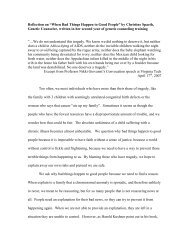
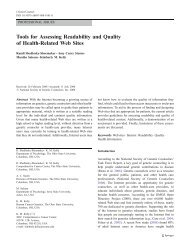

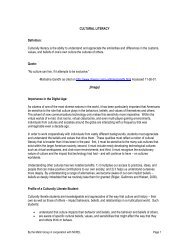
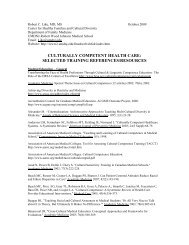

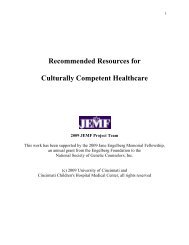

![Breaking Bad News PPT[1] - Genetic Counseling Cultural ...](https://img.yumpu.com/35003134/1/190x146/breaking-bad-news-ppt1-genetic-counseling-cultural-.jpg?quality=85)
